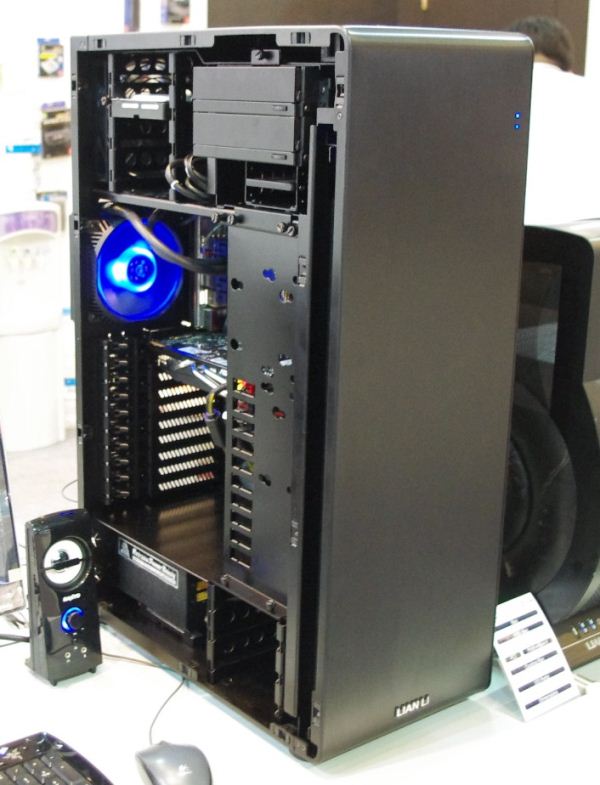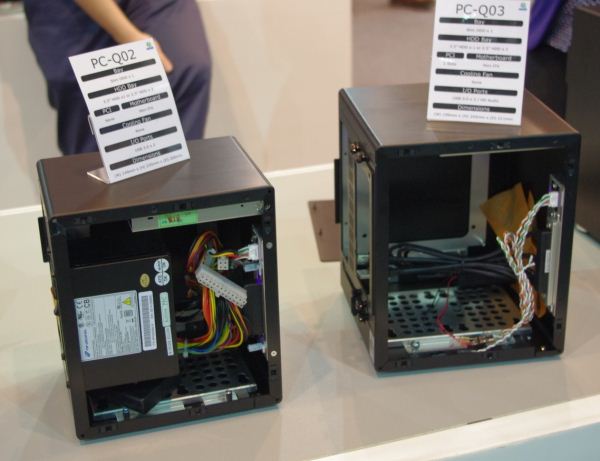Computex 2012: Lian Li Want To Sell You A Train, Or A Case with 26 3.5” HDD Slots
by Ian Cutress on June 8, 2012 11:23 PM EST- Posted in
- Trade Shows
- Computex 2012
- Lian
Visiting the Lian Li booth is always interesting. Last year we saw the TU-200 mini-ITX case aimed at taking a gaming machine with you on the move. This year, we get trains.
The PC-CK101 is a limited run product which looks like a train but will fit inside a mini-ITX motherboard with a couple of SSDs and appropriate power. On the case are a couple of USB 3.0 ports, and there is even room for a slim optical drive behind the cow catcher. The model on display was accompanied with a version of the case that had been outfitted with an engine and had fully moving parts along a track.
Also on the Lian Li booth we were introduced to the PC-D8000. A double width and tall case designed to fit HTPX motherboards as well as twenty-six 3.5 inch hard drives (6 of them in hotswappable bays).
This case looks like it would be great for organising a 4 dual radiator water cooling setup (the top has panels which can be switched with a dual 120mm fan slots), with plenty of space for organisation. Or, as I suggested, a modder may adjust the case to fit two motherboards and two systems – one system for low powered usage (word processing, email, internet), and a second system for gaming.
Also on display was the PC-V650, a mATX version of the PC-Q09B, and the PC-V750WX, a normal height E-ATX case. LianLi also showed me the PC-X2000FN, a very tall case which is only slightly wider than a motherboard, with space above and below for hard drives.
Mini-ITX cases are also the order of the day, with LianLi having their vertical power supplied PC-Q02 and PC-Q03.





















20 Comments
View All Comments
ajp_anton - Saturday, June 9, 2012 - link
Great for transporting you and your PC to LAN parties.augiem - Saturday, June 9, 2012 - link
You'll have to play the games from the good ol' days since stuff like SC2 are web-only now. I guess that's fine though since the older games are more fun anyway.JMC2000 - Saturday, June 9, 2012 - link
The PC-D8000 is like the spiritual successor to the old PC-343B. With dual 2.5"-3.5" adapters (and removal of the hot swap parts), one could hold at least 52 drives! Now, if 1+TB SSDs came in reasonable prices...I also really like that X2000FN, it looks somewhat better than the original X2000.
web2dot0 - Saturday, June 9, 2012 - link
I don't get why people get these types of cases. Why not just get a Supermicro Chassis? They're got cases in 2U factors carrying all the drives you want and everything you need. Why in the world would someone want all these drives for personal use?espaghetti - Sunday, June 10, 2012 - link
media serverweb2dot0 - Sunday, June 10, 2012 - link
Do you really need 26x3TB drives for your media server? You can't seriously think this is a realistic setup. The power requirement to power all these drives and backing that up is just not realistic for personal use.Even for workstation purpose .... why not just get a rack server and connect to it via WLAN or Ethernet? Seems very silly to me.
Brandenburgh_Man - Sunday, June 10, 2012 - link
"Do you really need 26x3TB drives for your media server? You can't seriously think this is a realistic setup. The power requirement to power all these drives and backing that up is just not realistic for personal use."Even 7200rpm hard drives don't draw more than 12 watts each while operating. A good 1000w power supply with lots of SATA port expanders can easily handle dozens of drives, with power to spare.
And nobody in the consumer market backs up huge data collections. What we do is buy professional controller cards with RAID 6 redundancy. That way, we could have any two drives fail simultaneously, and still not lose our data sets. Professional datacenters gave up on RAID 5 years ago, because what they found was that, sometimes while they were rebuilding a failed drive, they'd have a 2nd drive go bad on them before the array finished rebuilding. That caused them to lose the entire data set, and have to replace both drives and rebuild the dataset from tape backups, which turned out to be a very long and painful process. So RAID 6 is now the norm, and consumers with large datasets (like us Home Theater users) are following their example. There are even versions of Linux that allow 3 or more drives for redundancy, thus making it even less likely that anyone would ever have to have a "tertiary" form of backup, like tape. Someday I myself may do this, but for now I'm still in the Windows camp, which only supports RAID 6.
I've been collecting hi-def movies and TV shows for 12 years now. Four years ago I built a new computer using the old Lian-Li 343B double wide case, which can hold 24 hard drives in the front, and 6 more in the back above the power supply. At the time I thought it would take 10 years to fully populate it with hard drives, but just four years later I'm realizing that by the end of 2012 I will need to build a new system using a custom configured version of the Case Labs TX10 case that can eventually be expanded to hold 104 hard drives.
I started out 4 years ago with an Areca controller card that has 4GB of on-board cache and can handle 24 drives internally, plus 4 more drives on an external port. Beginning with eight 750GB Seagate drives in a RAID 6 array, I transferred my video collection from three old machines to this new one. (Took over a day to transfer just 4TB of data over a Gigabit LAN connection.)
But before the end of the first year I wound up adding eight 1.5TB Seagate drives in a 2nd RAID 6 array. During the 2nd year I expanded the 2nd Seagate array by adding yet another eight 1.5TB Seagate drives. This brought me up to 24 hard drives, maxing out the internal ports on the Areca controller card.
In the 3rd year I replaced the eight 750GB drives with twelve Hitachi 3TB drives, again using RAID 6. To do this, I had to buy a special expander cable to use the external port for those last four drives, winding up with a total of 28 hard drives on a single Areca controller card (16 1.5TB Seagate drives in RAID 6, and 12 3TB Hitachi's, also in RAID 6.)
By the end of this year (2012) I will have to buy a 2nd Areca controller card and more drives. Don't know yet if I will be buying another eight or twelve 3TB drives, or biting the bullet and going for 4TB drives. Either way, I can't possibly fit any more drives in the Lian-Li 343b case, but fortunately, Case Labs has the new TX10 that will hopefully last for the rest of my life. With the right motherboard, I could eventually have four Areca cards and 104 internal hard drives. But hard drives don't last forever (and yes, I've had a few fail on me and need to be replaced in the last few years), so by the time I finish populating the second Areca card I will certainly have replaced the 16 1.5TB Seagate drives with something newer - whether it's 3TB, 4TB or 5TB drives will depend on price and availability.
So - hopefully I will never really need 4 Areca cards. That in itself would require a 2nd redundant power supply and, since I never turn the computer off (I'm always downloading stuff from the multimedia news servers), it would definitely have an impact on my electric bill.
But I'm hoping that by replacing old hard drives every two or three years with higher capacity models, I've never outgrow two Areca cards (keeping fingers crossed).
I realize I'm in a niche market, but I know other people with their own huge collections, spread out among half a dozen computers, and they're all planning on consolidating their collections into a single machine like I did. Just as the market for SLI and Crossfire configurations is small, the market for Home Theater "Datacenters in a box" is also small. But it's certainly not non-existent.
SlyNine - Monday, June 11, 2012 - link
FlexRaid is great for media backups. You will only EVER lose the data on the drives that failed, you can have as many parity drives as you want and you don't have to rebuild anything to add more drives.Aikouka - Sunday, June 10, 2012 - link
I typically organize my hard drives with space in between them like they show in the D8000's photo. Considering that this halves the number of hard drives (only 10 in the photo vs. 20 available slots), you'll see why copious amounts of room is a good thing.SlyNine - Monday, June 11, 2012 - link
I have 16TB of space. It's pretty much 70% full right now and I plan on trippling my storage in 2 years.